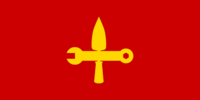Democratic Lazonesia
This article refers to a micronation or element of micronationalism which is defunct and no longer exists. You can help make the article reflect that or ask on the talk page for further information. |
Democratic Lazonesia Lazonesia Democrática (Spanish) | |
|---|---|
| Motto: "Glory to Lazonesia!" | |
| Anthem: "The Internationale" | |
 Location of Democratic Lazonesia in North America. | |
| Status | Active |
| Capital | Platana |
| Official languages | |
| Ethnic groups (2020) |
|
| Religion (2023) |
|
| Demonym(s) | Lazonesian |
| Government | Unitary one-party socialist republic |
• General Secretary and Chairman of State Affairs | Lucas Gonyer |
• Premier | Steven Liu |
| Legislature | Lazonesian People's Assembly |
| Independence from Canada | |
• Independence | 10 October 2020 |
• Constitution ratified | 15 November 2023 |
| Population | |
• 2023 census | 14 |
| HDI | 0.936 very high |
| Currency | Lazonesian Peso |
| Time zone | UTC−8 (PST) |
• Summer (DST) | UTC−7 (PDT) |
| Date format | mm/dd/yyyy |
| Driving side | right |
| Calling code | +1 |
| Internet TLD | .dl (proposed) |
Website example | |
Lazonesia, officially Democratic Lazonesia (Spanish: Lazonesia Democrática), is a North American micronation located in the Pacific Northwest. Lazonesia declared its independence in 2020 but its existence is not formally recognized by the United Nations or the government of any sovereign state.[1]
Lazonesia is commonly viewed as a communist state by outside observers, while its constitution formally describes the nation as a socialist "workers' and peasants' state". It is governed under a one-party system with the ruling Workers' Party of Lazonesia assuming a leading role in all state affairs. The party's General Secretary acts as the country's de facto head of state while the Premier serves as head of government. Lazonesia was founded on Vancouver Island by Canadian micronationalist Lucas GonyerF, initially as a tongue-in-cheek social and political experiment to see how a government modeled closely upon those of Cuba and North Korea could function within a micronational framework. It has since grown into a functional nation-state with serious aspirations of achieving internationally recognized statehood.
The nation's foreign policy prioritizes diplomacy with other micronations and independence movements, as well as pressing its rights to self-determination in the wider international community. Lazonesia also dedicates its efforts towards developing its small but highly diversified economy. It currently has a population of 14 citizens living both inside and outside of its territorial boundaries.
Etymology
The exact origins of the name Lazonesia are not fully known, but Lazo is widely believed to represent Cape Lazo, the geographical region where the micronation is located. Citizens of Lazonesia are known by the demonym Lazonesian.
History
The Lazonesian government was established on 10 October 2020, initially as the Commonwealth of Lazonesia, under a system of constitutional monarchy. It briefly joined another Vancouver Island-based micronation, the Dominion of Vancouver Island, in an "act of union" in early 2021 before seceding soon afterwards and once again declaring itself an independent state. The fledgling nation later dropped the prefix Commonwealth and adopted the name Democratic Lazonesia. The constitutional monarchy was abolished and socialism with a highly centralized economy was instituted to speed up the country's development. The Workers' Party of Lazonesia was founded on 2 March 2021 with founding father Lucas Gonyer assuming the leading position of General Secretary, as well as the creation of the Lazonesian People's Army on 15 April 2021. Despite initial success, the COVID-19 pandemic brought nearly all state functions to a halt by late 2021 and Democratic Lazonesia entered a lengthy hiatus by the end of that year.
In late 2023, activity began to resume within the political and military apparatus, and an official revival of Democratic Lazonesia was formally announced on 4 November 2023. Recent developments have included the publication of the nation's first constitution as well as the creation of an official government website and accounts on several major social media platforms.
Politics and government
The Constitution of Democratic Lazonesia describes the country as a "revolutionary socialist state" committed to communism, political unitarism, and the guidance of Lucas Gonyer who is credited as the "founder of Democratic Lazonesia" and the "father of the Lazonesian socialist revolution."
General Secretary
The General Secretary of the Workers' Party of Lazonesia (WPL) is the country's de facto supreme leader, simultaneously holding the positions of leader of the WPL, Chairman of State Affairs, and Commander-in-Chief of the nation's armed forces. Party rules stipulate that the general secretary is elected by the party congress to a renewable five-year term.
Chairman of State Affairs
The formal head of state of Democratic Lazonesia is the Chairman of the State Affairs Committee, the nation's highest organ of leadership. While the chairman is formally elected by the nation's legislature, the People's Assembly, the position is always held by the general secretary of the WPL and has no formal term limit. The chairman has the power to lead the overall affairs of state and policy, and appoint all diplomatic officials. The chairman has the authority to appoint diplomatic representatives abroad, conclude treaties with foreign powers, declare a state of emergency or a state of war, and direct the national defense of Democratic Lazonesia during times of war in the capacity of general secretary.
Premier
The Premier of Democratic Lazonesia is vice-chairman of the State Affairs Committee and acts as the country's head of government. The premier is appointed by the People's Assembly to a renewable five-year term and serves as the government's primary representative, as well as a close advisor to the chairman.
People's Assembly
If your nation has a legislative branch, explain its function and structure here, titling the section with the name of the legislative body.
Use ====Level 4 headings==== for the upper and lower houses or chambers.
Political parties
The Workers' Party of Lazonesia (WPL) is the sole ruling party of Democratic Lazonesia and controls the nation's armed forces, the Lazonesian People's Army. Smaller political parties are permitted to exist so long as they accept the "leading role" of the WPL. Officially, the WPL is a communist party guided by Lucasism, a combination of Marxism-Leninism, Juche, and the political theories of Lucas Gonyer.

| Logo | Name | Spectrum | Ideologies | Seats | ||
|---|---|---|---|---|---|---|

|
Workers' Party of Lazonesia | WPL | Far-left | Communism Lucasism Marxism-Leninism Left-wing nationalism Socialist patriotism |
5 / 5
| |
Law and order
Insert information about the nation's judicial system and/or law enforcement.
Military
Lazonesian People's Army. Insert brief information about the structure of the nation's military, its branches, the weaponry used, and notable conflicts the nation was involved in.
Ministries
If your nation has ministries managing certain fields, explain them here under ==== Level 4 headings.==== Some information to include might be the powers that the ministry has, the history of ministries in the nation, etc. For example:
Ministry of Example
The ministry of example is responsible for {task} and {task} in the Example Republic. It was established on 20 April 2022 under the Ministry Act to manage [certain aspect of the nation].
Foreign relations
To date, Democratic Lazonesia has not received diplomatic recognition from the government of any internationally recognized sovereign state, but it has established diplomatic relations with several other micronations and independence movements. The Lazonesian government cites the declarative theory of statehood, famously expressed in the 1933 Montevideo Convention, as legal justification for statehood since it meets the criteria to be considered a sovereign nation.[a]
Lazonesia has appointed several diplomatic officials abroad to press its rights for self-determination. Its government formally recognizes the sovereignty of over 200 nations worldwide.
Unilateral recognition
 All United Nations member states
All United Nations member states British West Florida
British West Florida Cook Islands
Cook Islands Flandrensis
Flandrensis Haida Nation
Haida Nation Holy See
Holy See Manchukuo
Manchukuo Molossia
Molossia Niue
Niue Palestine
Palestine Sealand
Sealand Somaliland
Somaliland Westarctica
Westarctica
Mutual recognition
Recognition refused
Administrative regions
Explain your nation's claim system, and the various types of constituencies your nation may have, for example, the difference between a district and a territory. It is preferred that you do not discuss each constituency in this section. Instead, the names of each constituency in the table should be linked to their own separate articles. You can add and remove columns as you wish, but generally, include fields for the flags (which should be kept small, at most 100px wide (less if more rows listed) and have a border), name, and important fields such as area, population, governor and/or representative (or equivalent position). You do not need to include a column for a seal, flag, or coat of arms for each constituency if it they do not have one.
| Flag | Arms/Seal/Emblem (optional) |
Name | Area | Population | Officials |
|---|---|---|---|---|---|
| {Constituencies} | |||||

|

|
Example District | |||

|

|
Second Example District | |||
| {Second type of constituency} | |||||

|

|
Example Territory | |||

|

|
Second Example Territory | |||
Geography and climate

Use this section to write about the terrain, climate, weather, and location of your micronation. A good template for listing annual temperature data is {{Weather box}}.
Economy
Insert fiscal information, such as the micronation's exports, imports, and industries. You can briefly discuss the micronation's currency but that should generally be kept in a separate article.
Culture
Insert information about the micronation's holidays, customs, education, spoken languages, arts, the press, and television here.
Holidays
It is recommended to use the following table for holidays:
| Date | Name | Remarks |
|---|---|---|
| 1 January | New Year's Day | Celebration of the start of the new year. |
| Third Monday in February | Family Day | Shared statutory holiday with British Columbia. |
| 8 March | International Women's Day | Celebration of women's rights, gender equality and reproductive rights. |
| 1 May | International Workers' Day | Celebration of labourers, the working class and the international labour movement. |
| 27 July | Ginger Goodwin Day | Observation of the martyrdom of labour activist Albert "Ginger" Goodwin" who was murdered on this day in 1918. Red roses are typically left at his burial site followed by a moment of silence. |
| 13 August | El Comandante Day | Commemoration of the birth of Fidel Castro on this day in 1926. |
| 30 September | National Day for Truth and Reconciliation | Recognition of the impact of the Canadian residential school system on Indigenous children (shared with British Columbia). |
| 10 October | Revolution Day | Commemoration of the establishment of the Democratic Republic of Lazonesia on this day in 2020. |
| 11 November | Remembrance Day | Memorial holiday shared with Canada. Honors Canada's war dead. Anniversary of the armistice ending World War I in 1918. |
| 25 December | Christmas Day | Commemoration of the birth of Jesus of Nazareth. |
See also
Related pages, in a bulleted list. DO NOT include links to categories, articles of allied nations, or pages already linked in the article.
Notes
- ↑ The declarative theory of statehood defines a state as a person in international law if it meets the following criteria: 1) a defined territory; 2) a permanent population; 3) a government and 4) a capacity to enter into relations with other states.
References
- ↑ "Independent States of the World" nationsonline.org
External links
External links are for, well, links to external sites. If you are a new editor, you must have at least five edits to be able to add external links. These can include your nation's official site, citizenship application, and social media links. Links should be added in a bulleted list, for example:

